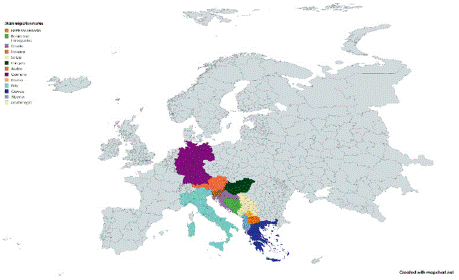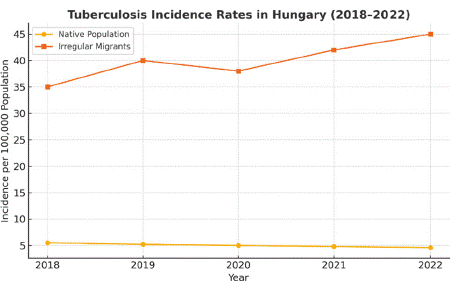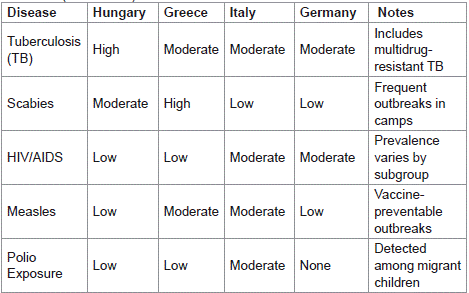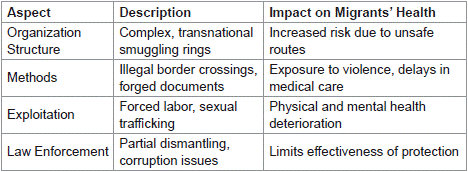
Research Article
Austin J Public Health Epidemiol. 2025; 12(2): 1177.
Public Health Risks and Criminal Implications of Irregular Migration to Europe
Robert Gyuricsko¹*, Iván Zádori² and István Kobolka²
¹Department of Public Health, University of Pécs, Hungary
²University of Pécs University Professor or Researcher, Hungary
*Corresponding author: Robert Gyuricsko, Department of Public Health, University of Pécs, Szigeti út 12, 7624 Pécs, Hungary Tel: +36-72-123-4567; Fax: +36-72-765-4321; Email: gyuricskorobert@gmail.com
Received: June 26, 2025 Accepted: July 15, 2025 Published: June 18, 2025
Abstract
Irregular migration to Europe via the Balkan route has increased considerably between 2018 and 2023, presenting complex public health and security challenges. This study analyzes epidemiological data and migration trends to assess the resurgence of infectious diseases such as tuberculosis, scabies, HIV/AIDS, and vaccine-preventable illnesses among irregular migrants. It further explores the role of criminal smuggling and human trafficking networks in exacerbating health risks and border security concerns. Using data from the European Border and Coast Guard Agency (Frontex), the World Health Organization (WHO), and national health authorities, the study highlights case studies from Hungary, Greece, Italy, and Germany, illustrating the strain on health systems and law enforcement. The findings underscore the necessity for coordinated cross-sectoral responses integrating health screenings, improved living conditions, and enhanced international cooperation, while respecting migrants’ human rights. The study recommends policy frameworks balancing epidemiological imperatives and humanitarian obligations to address this ongoing challenge effectively.
Keywords: Irregular migration; Public health; Infectious diseases; Tuberculosis; Human trafficking; Balkan route
Abbreviations
EU: European Union; WHO: World Health Organization; TB: Tuberculosis; COVID-19: Coronavirus Disease 2019; Frontex: European Border and Coast Guard Agency.
Introduction
Irregular migration to Europe has emerged as a multifaceted challenge encompassing social, political, public health, and security dimensions [1]. Driven by conflict, economic instability, and political repression in regions such as Africa, the Middle East, and parts of Asia, large numbers of migrants seek entry through unofficial routes, notably the Balkan corridor [2]. This influx stresses border agencies and public health systems, which must address both security and emerging health concerns.
Historically, the European Union has largely eradicated many infectious diseases through vaccination programs and surveillance. However, migrants from regions with endemic diseases risk reintroducing infections such as tuberculosis (TB), measles, polio, and scabies [3,4]. Overcrowded reception centers and informal camps often lack adequate sanitation and healthcare access, facilitating disease transmission [5].
Additionally, irregular migration routes are exploited by organized criminal networks engaged in smuggling and human trafficking, further complicating health risks and law enforcement efforts [6]. Migrants face exploitation and harsh conditions, worsening physical and mental health outcomes [7].
This study analyzes migration data and public health reports from 2018 to 2023 to assess the epidemiological impact of irregular migration via the Balkan route and its intersection with criminal activity. It aims to provide evidence-based recommendations for policy and intervention strategies balancing security, public health, and human rights.
Materials and Methods
Data Sources
Data were collected from Frontex annual reports (2018–2023) on irregular border crossings, WHO epidemiological bulletins, and public health databases from Hungary, Greece, Italy, and Germany [8-10]. Supplementary information was gathered from peer-reviewed literature and NGO reports concerning migrant health and trafficking [11,12].
Study Design
A descriptive epidemiological approach was employed, integrating quantitative migration and disease incidence data with qualitative assessments of smuggling networks and border policies.
Inclusion Criteria
The study focused on irregular migrants entering or transiting through EU member states via the Balkan route and infectious diseases reported in this population, including TB, scabies, HIV/ AIDS, and vaccine-preventable diseases.
Analysis
Migration volumes and disease prevalence were analyzed descriptively. Case studies highlight country-specific challenges. Qualitative data on smuggling and trafficking were thematically analyzed to understand the nexus between irregular migration and criminal activity.
Limitations
Potential underreporting and inconsistent national data pose challenges. Migrant reluctance to seek healthcare may lead to underestimated disease burden.
Results and Discussion
Migration Patterns
From 2018 to 2023, irregular crossings along the Western Balkan route increased markedly, peaking in 2021 after regional conflicts intensified [8]. Countries such as Serbia, Bosnia and Herzegovina, and Hungary became major transit hubs, with migrants often residing temporarily in informal camps or detention centers [9]. The migrant demographic predominantly comprised young males from Afghanistan, Syria, Iraq, and Sub-Saharan African nations [10] (Figure 1).

Figure 1: Map of irregular migration routes through the Western Balkan
corridor (Frontex, 2023).
Infectious Disease Burden
Tuberculosis (TB): TB incidence among migrants was significantly higher than in native populations, with multidrugresistant strains posing treatment challenges (Figure 2). Hungary reported increasing TB cases in border detention facilities between 2019 and 2022 [13]. Delayed diagnosis due to fear of deportation impeded effective treatment.

Figure 2: Incidence rates of tuberculosis among migrants versus native
populations in Hungary (2018–2022).
Scabies and Other Skin Diseases: Overcrowding and poor hygiene in camps led to frequent scabies outbreaks, documented in Serbia and Bosnia [14]. These conditions amplify secondary infections and burden healthcare providers.
HIV/AIDS: Certain migrant groups demonstrated higher HIV prevalence compared to the local population, complicated by limited access to antiretroviral therapy and stigma [15].
Vaccine-Preventable Diseases: Low vaccination rates among migrants led to measles and polio outbreaks in Greek and Italian reception centers, prompting emergency immunization efforts [16,17].
The COVID-19 pandemic exacerbated vulnerabilities due to restricted testing and vaccination among migrants [18].
Case Studies
Hungary: Röszke border detention center saw a rise in TB and scabies, linked to overcrowding and insufficient healthcare [13].
Greece: Lesbos and Samos camps experienced measles outbreaks in 2019–2020, complicated by logistical and trust barriers to vaccination [16].
Italy: Sicily healthcare services detected poliovirus exposure among migrants from Africa, resulting in WHO-coordinated immunizations [17].
Germany: Berlin clinics noted rising chronic and infectious diseases in undocumented migrants, revealing gaps in healthcare inclusivity [19] (Table 1).

Table 1: Infectious Diseases Reported Among Irregular Migrants in Key Transit
Countries (2018–2023).
Public Health Impact
The influx strained health systems, requiring expanded screening and treatment capacity, often without matching resources [20]. Language barriers and undocumented status complicated access.
Criminal Networks and Human Trafficking
Organized smuggling rings facilitate irregular migration, charging high fees and exposing migrants to exploitation including forced labor and sexual trafficking [6,21] (Table 2). This nexus worsens health outcomes and challenges border control.

Table 2: Characteristics of Smuggling and Trafficking Networks Affecting
Migrant Health.
Law enforcement efforts partially disrupt these networks but face obstacles due to corruption and fragmented international coordination [21].
Policy and Response
Recommendations include standardized health screenings at borders, improved sanitation in camps, migrant-inclusive healthcare policies, and enhanced cooperation between health authorities, border agencies, and NGOs [22]. Balancing health security with human rights is crucial to avoid stigma and discrimination [23].
Conclusion
Irregular migration through the Balkan route presents significant public health risks, including re-emerging infectious diseases, compounded by criminal smuggling and trafficking. Addressing these challenges requires integrated health and security strategies prioritizing migrant welfare and epidemiological control. Enhanced cross-border cooperation, improved health infrastructure, and rightsbased policies are essential for managing this ongoing complex phenomenon.
References
- European Commission. Migration and asylum data. 2022.
- Frontex. Annual risk analysis reports 2018–2023. European Border and Coast Guard Agency.
- Rechel B, Mladovsky P, Ingleby D. Migration and health in the European Union: Key challenges and responses. Lancet. 2020; 395: 1997-2004.
- Biesma Blanco JL, Moreira IA, Da Silva JF. Public health consequences of migration in Europe: A systematic review. Int J Public Health. 2020; 65: 543- 552.
- Hodkinson B, Johansen P, Larsen A. Scabies outbreaks in migrant populations: Challenges for health services. Eur J Public Health. 2021; 31: 441-447.
- United Nations Office on Drugs and Crime. Global report on trafficking in persons. 2023.
- International Organization for Migration. Migration health and human rights in Europe. 2022.
- European Migration Network. Migration routes through the Western Balkans. 2022.
- UNHCR. Refugee and migrant arrivals in Europe: Trends and challenges. 2022.
- Del Amo J, Bracchi M, Bucher HC, Balestre E. HIV prevalence and incidence among migrant populations in Europe: A systematic review. AIDS. 2020; 34: 911-920.
- Kovács Z, Szabó G, Tóth M. Tuberculosis in detention centers on the Hungarian border: Challenges and solutions. BMC Public Health. 2021; 21: 1124.
- Papadopoulou V, Kapsali E, Dimitrakopoulos S. Measles outbreaks in Greek migrant camps: Lessons learned. Vaccine. 2021; 39: 6461-6467.
- Giovani R, Rossi C, Moretti M. Poliovirus exposure among migrants arriving in Italy: Epidemiological insights. Vaccine. 2020; 38: 1593-1598.
- Norredam M, Nielsen SS, Krasnik A. COVID-19 and migrant health inequalities in Europe: An urgent call for action. Eur J Public Health. 2021; 31: 452-453.
- Schneider C, Müller A, Fischer A. Healthcare access among undocumented migrants in Germany: A mixed-methods study. BMC Health Serv Res. 2022; 22: 1027.
- Mladovsky P, Maresso A, Hernández-Quevedo C. Migrant health and healthcare access in Europe: Policy challenges. Health Policy. 2019; 123: 844-851.
- World Health Organization Europe. Vaccine-preventable disease outbreaks among migrants in Europe. 2022.
- European Centre for Disease Prevention and Control. Tuberculosis surveillance and monitoring in Europe 2022.
- World Health Organization. European health reports and bulletins. 2019- 2023.
- European Migration Network. Annual Report. 2022.
- United Nations Office on Drugs and Crime. Trafficking and smuggling nexus. 2023.
- Frontex. Joint health screening guidelines for border control. 2023.
- International Organization for Migration. Human rights in migrant health policy. 2022.